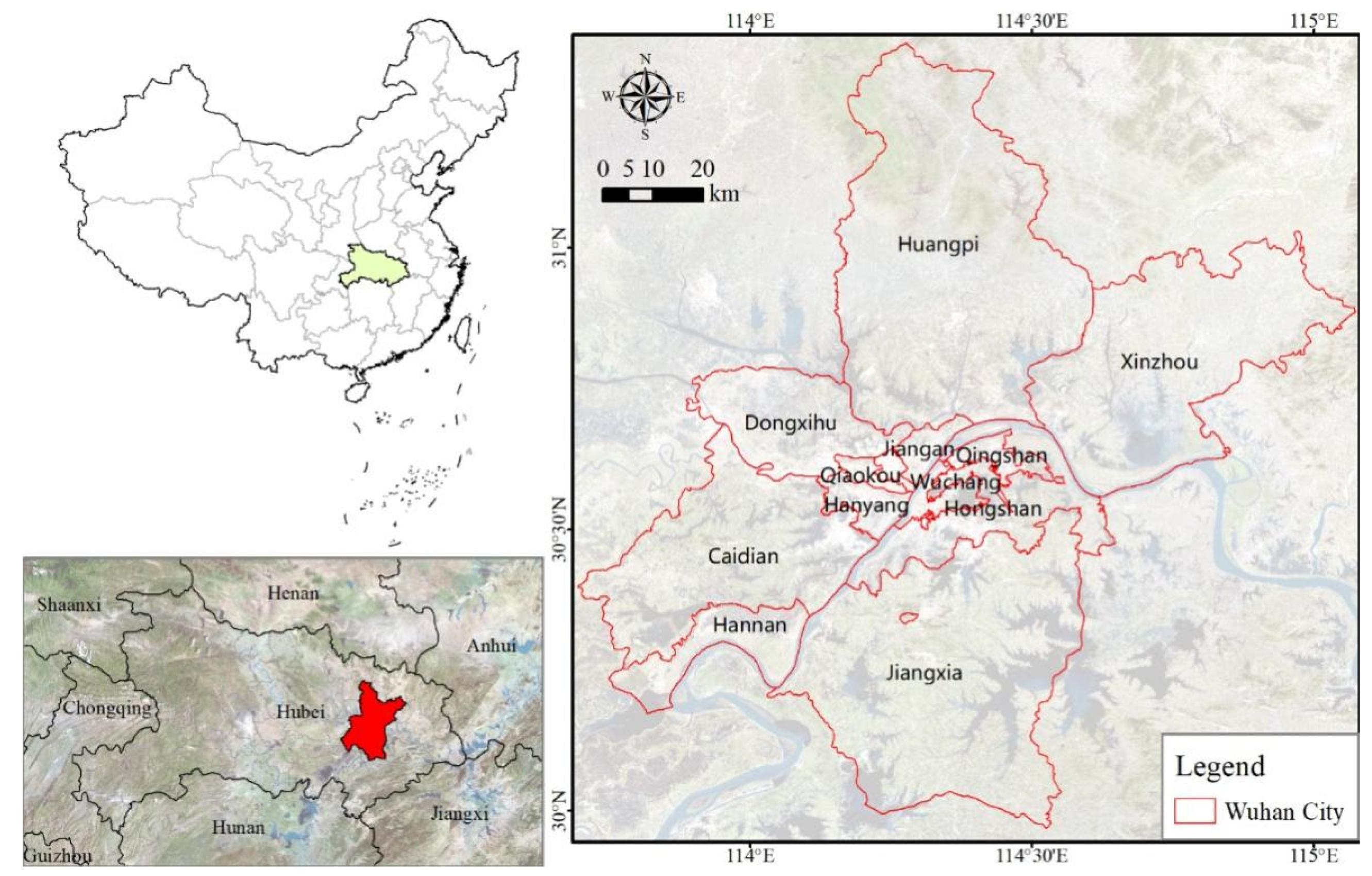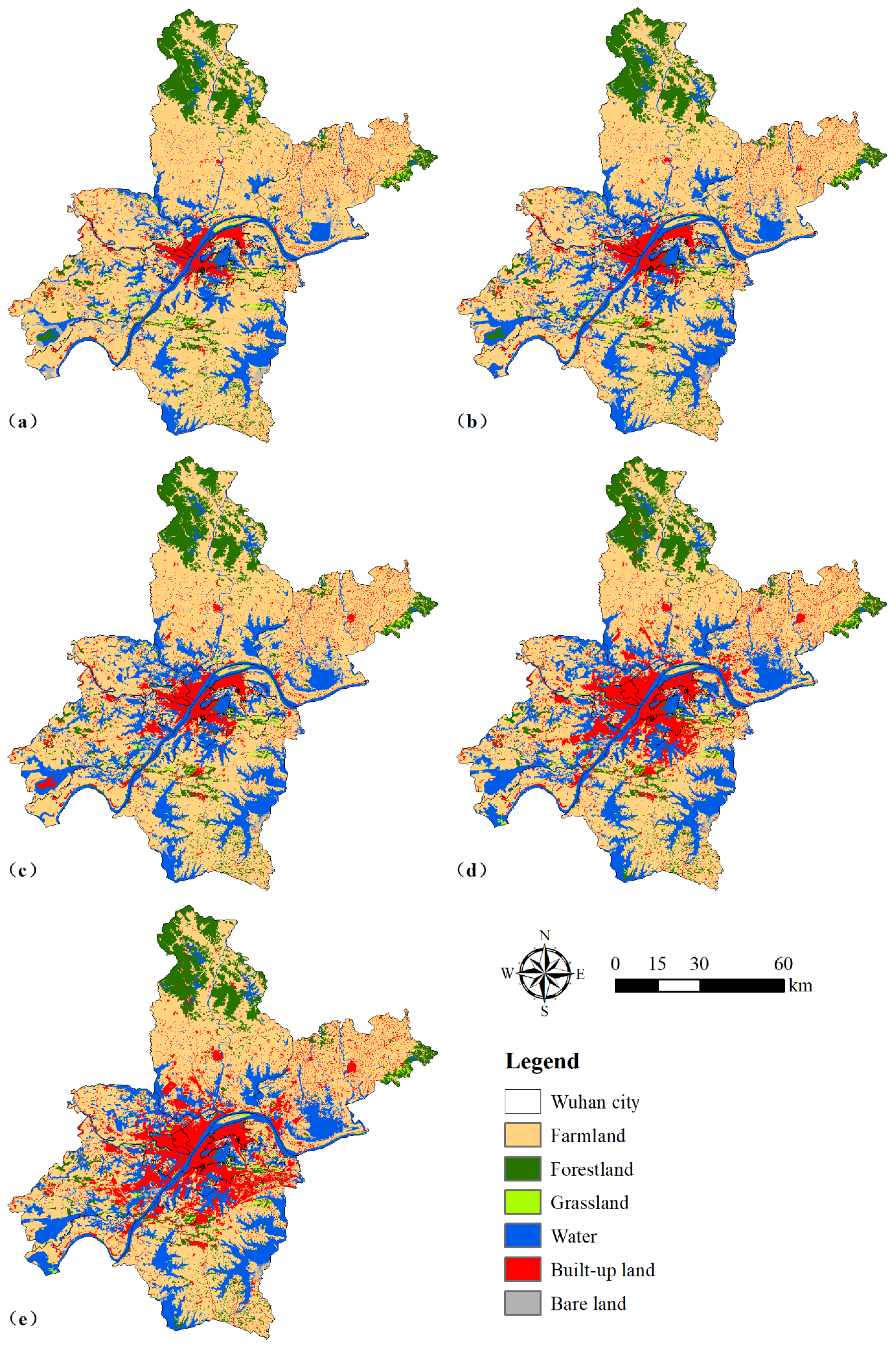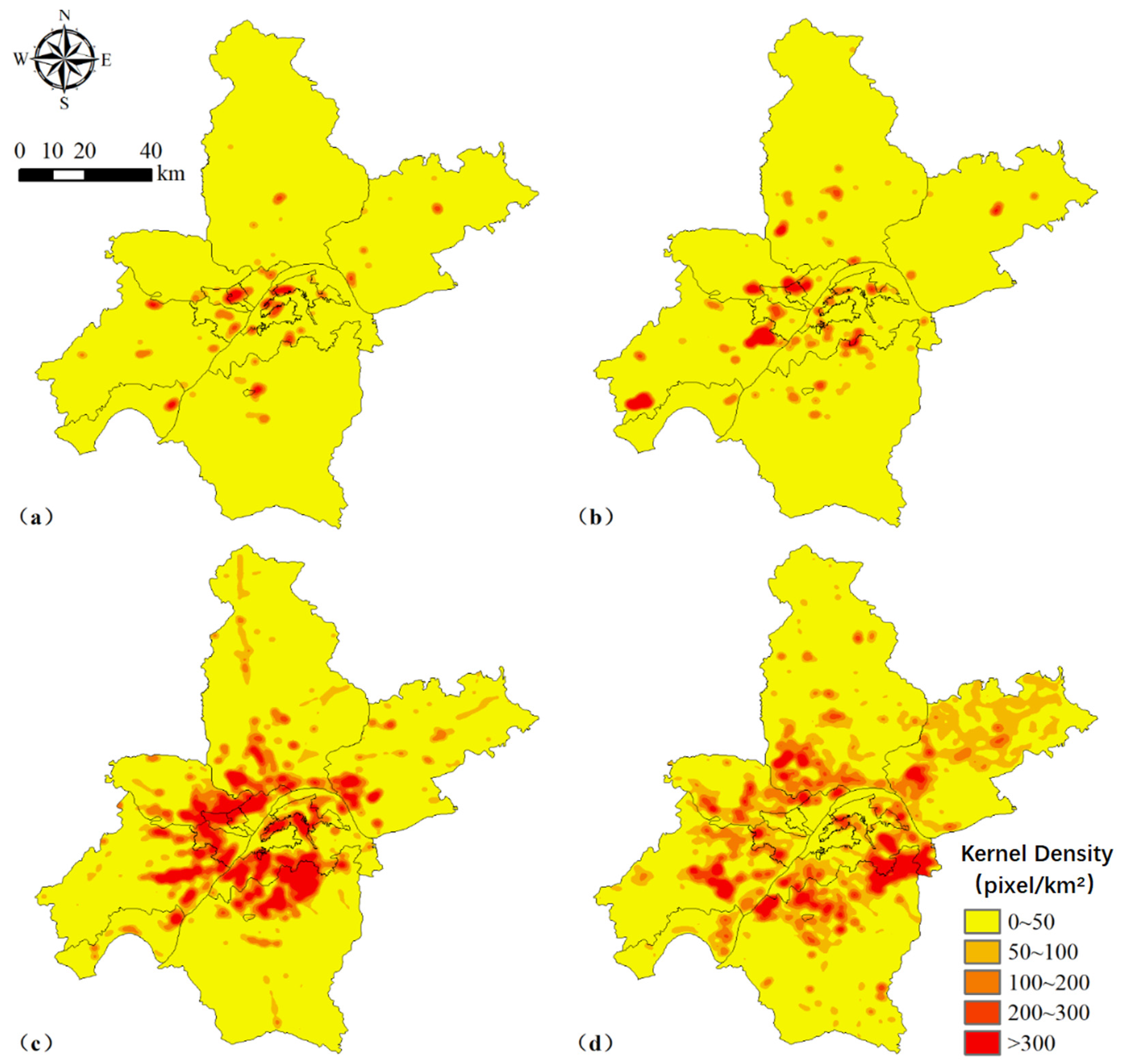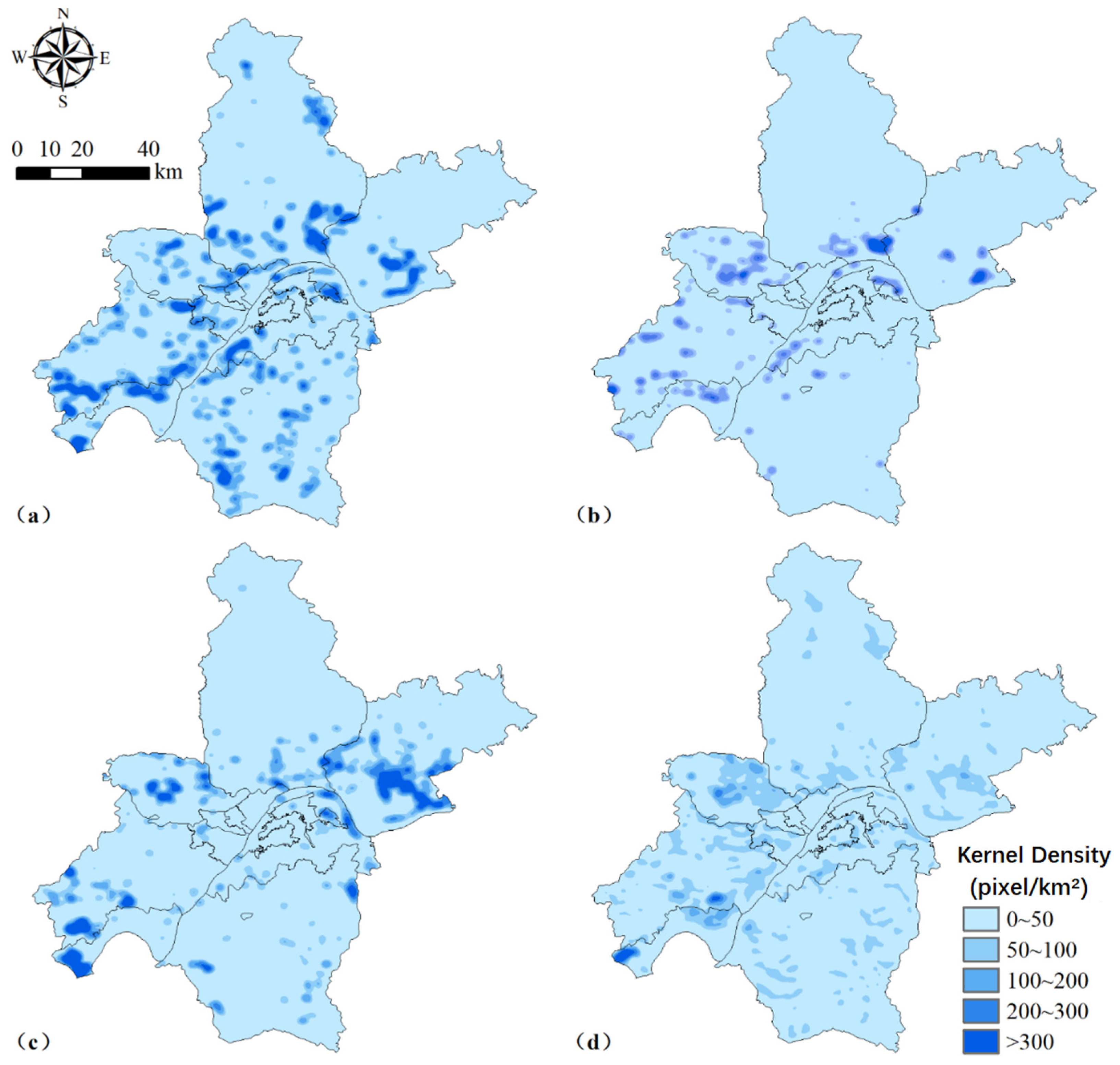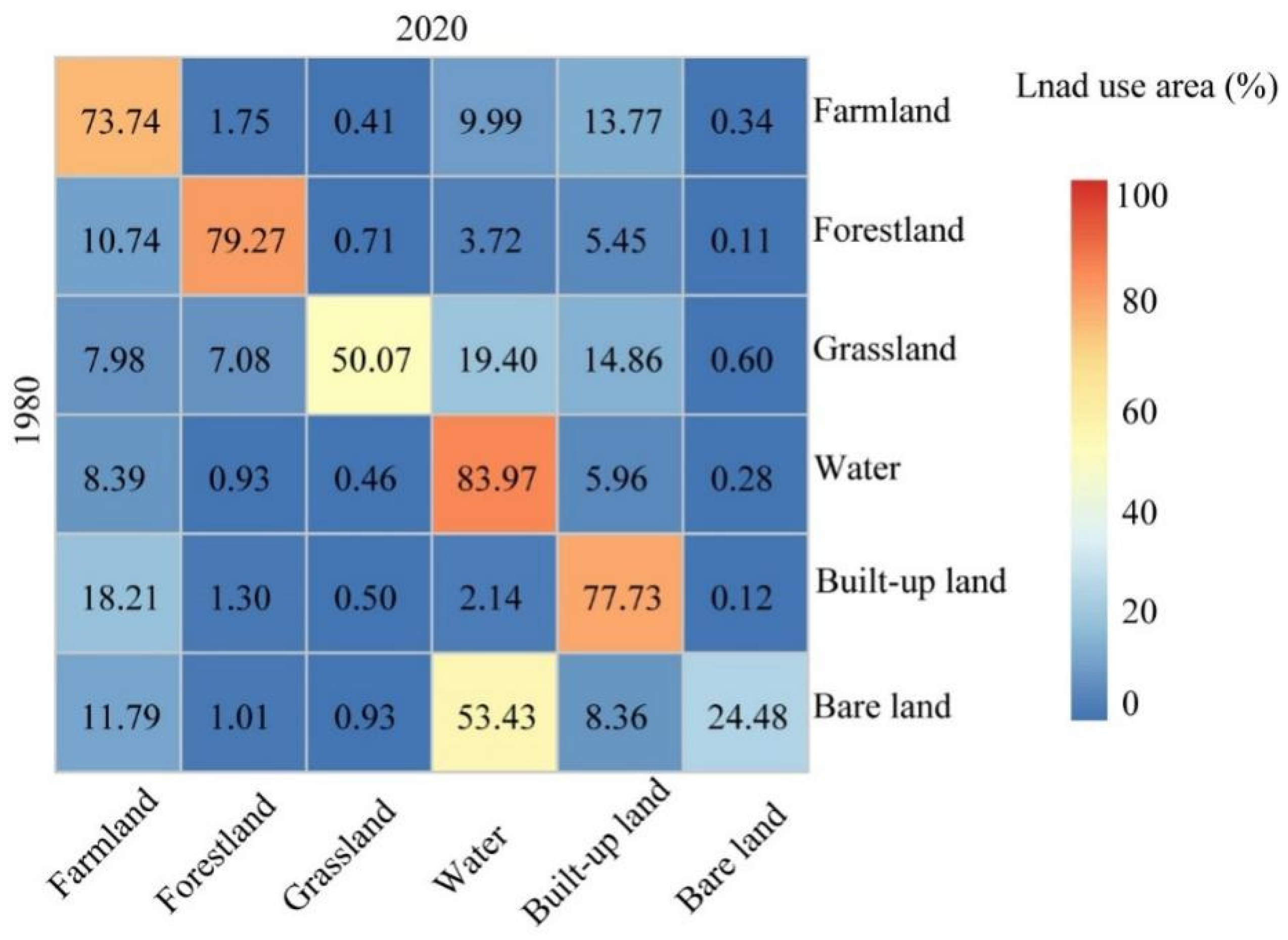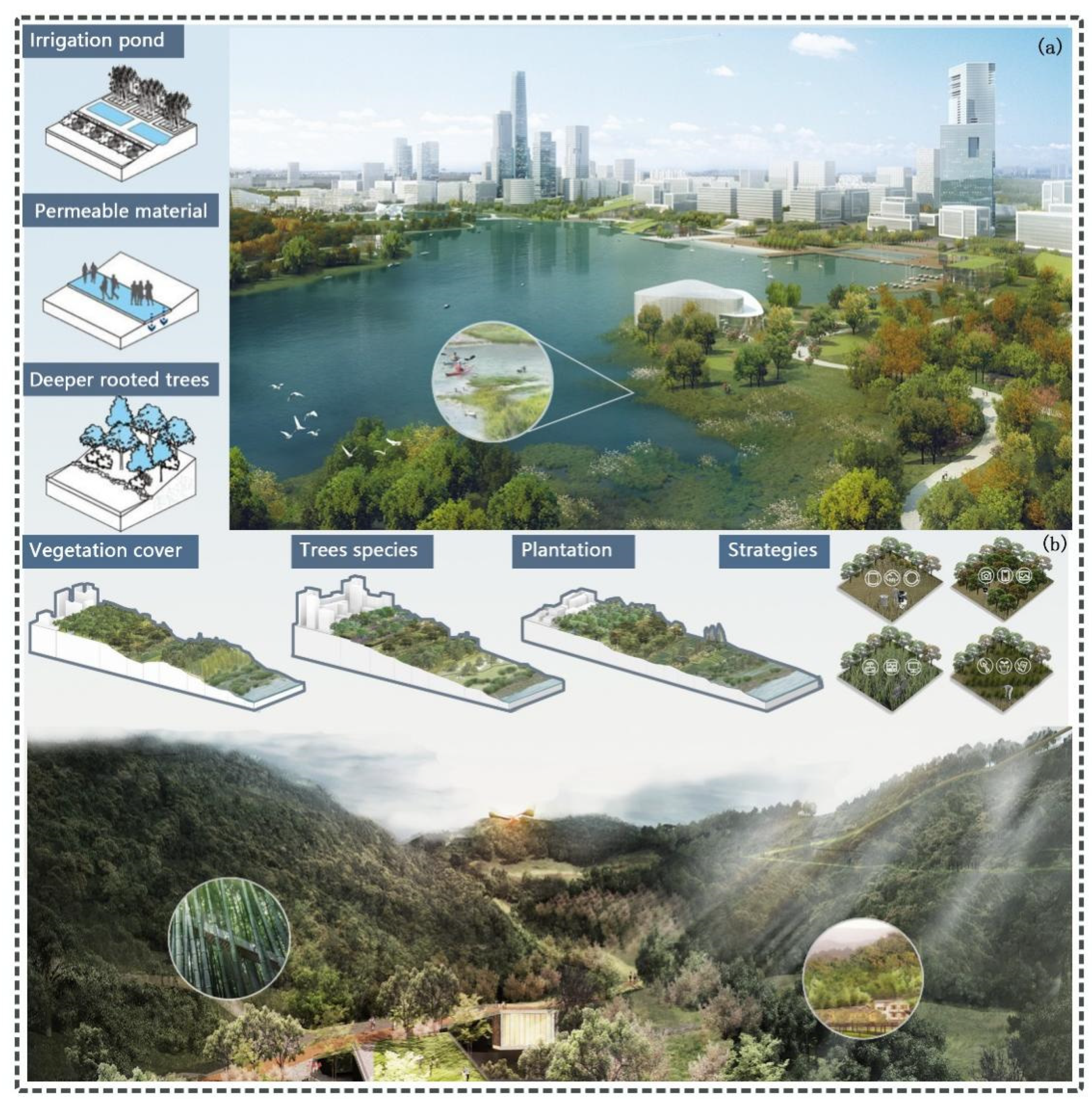1. Introduction
Landscape change is the basis of resource, environmental, and ecological research and scientific management, and it directly reflects the response of regional ecosystem structures and processes to environmental change [
1,
2]. It not only objectively records the spatial patterns of the earth’s surface features that are altered by human activities, but also reproduces the spatial and temporal dynamics of the earth’s surface landscape [
3]. Since the reform and opening up of China, rapid urbanization and industrialization, as well as enhanced ecological protection measures, have led to tremendous pressure and challenges in relation to landscapes in China, which have in turn greatly influenced landscape changes [
4,
5]. For example, Li et al. [
6] used geographically weighted regression (GWR) to identify the spatial non-stationary relationship between urbanization and landscape patterns in Beijing City, China, demonstrating that urbanization would result in the expansion of built-up land and thus make the landscape more fragmented and irregular. Li et al. [
7] used recently developed built-up data and land use data to describe the impact of human settlement expansion on landscape fragmentation and its spatio-temporal heterogeneity in China between 1975 and 2014, finding that the mean built-up area ratio increased by three times over the 40 years in China, which resulted in a significant change in the landscape fragmentation pattern. However, landscape change often generates a variety of environmental problems that aggravate regional landscape competition and conflicts, thus indirectly affecting the supply of ecosystem services [
8,
9]. It can also have an impact on the goods and services provided by ecosystems by altering their type and intensity [
10]. Therefore, it is important to quantitatively describe the complex spatial and temporal processes of landscape changes and to further reveal the relationships between ecosystem service changes and different landscapes. This is beneficial for understanding their ecological and economic relationships, which can provide reference information for land resource planning and eco-environmental monitoring [
2,
11].
Landscape change driven by urbanization is a major contributor to changes in the spatio-temporal dynamics of ecosystems and is a major factor driving ecosystem service losses [
12,
13]. The ecosystem service value (ESV) is the value of goods and services provided by ecosystems for human well-being, and is the main indicator for assessing ecosystem change. It quantifies the direct or indirect human benefits from ecosystem functions [
14,
15]. Currently, some studies (e.g., Cai et al. [
16] and Hu et al. [
17]) have demonstrated the relationship between urbanization and ESV, suggesting that urbanization indirectly leads to ESV changes by affecting the structure and function of natural ecosystems. Peng et al. [
18] also found that urbanization can affect the flow of materials, energy, and information by changing landscape patterns, which in turn changes the services provided by regional ecosystems to humans. However, most studies have only used a single or several ecosystem services to assess the response of ESV to urbanization. The intrinsic linkages among various ecosystem services remain unclear. Therefore, an integrated study of ESV changes in various ecosystems is necessary to help understand the contribution of ecosystem service functions to socioeconomic development and provide a knowledge base for relevant policy decisions.
Costanza et al. [
19] first proposed an ecosystem assessment method and estimated 17 ecosystems provided by 16 land resources [
16,
20]. This caused ESV to be widely studied globally, and it has become a research hotspot for environmental impact assessments [
21,
22]. However, this method has high requirements in terms of data collection and processing, and the calculation is relatively complicated and is not generalized [
23]. Therefore, Xie et al. [
24] conducted a questionnaire survey of domestic ecologists and revised the coefficient table based on that of Costanza et al. [
19]. Compared with other methods, this method is considered more practical and has the advantages of low data requirements, high comparability of results, and the ability for comprehensive evaluation, and it has been widely used for ESV assessments in China [
15,
25,
26]. Therefore, in this study we selected 11 ecosystem services to study the trends of ESV changes based on the classification system of Xie et al. [
24].
Wuhan city is the largest city in the central part of China, with a unique geographical location and a good economic foundation [
10,
27]. It is currently recognized as the center of finance, education, and transportation in central China, and has been identified as a core region of the Central Rising Strategy and China’s Yangtze River Economic Belt Development Strategy [
20]. This has driven the evolution of Wuhan’s spatial pattern in the landscape, leading to a rapid urbanization period with large-scale population migration [
28,
29]. However, this evolution has exposed the landscape to the pressures and challenges of the continuous expansion of built-up land and the accelerated degradation of ecological land, and has brought about many eco-environmental problems, such as lake reclamation, water pollution, and farmland erosion [
5,
25]. These human activities have disrupted the ecological balance of the lake and reduced its self-regulating capacity, thus leading to frequent urban flooding and even inducing catastrophic weather in local areas [
21,
30]. In addition, the expansion of built-up land at the cost of ecological land has led to a huge loss of high-quality farmland and a drastic degradation of ecosystem services in Wuhan [
21,
31]. Therefore, it is urgent to study the dynamic changes and transfer probabilities of ecological land in order to alleviate the landscape conflicts, improve the ecological environment, as well as to maintain sustainable development [
5,
32], so as to provide a scientific basis for the optimization of ecological land in Wuhan and the formulation of urban planning.
To understand the trends of landscape changes in Wuhan during 1980–2020, we studied the spatial and temporal characteristics of the landscape, using four indicators (net total change area, annual change area, annual change rate, and dynamic degree) and kernel density analysis. The conversion matrix was used to determine the conversion direction of various land use types. In addition, we estimated the ESV of the region at different periods using an improved unit area value equivalent method to reveal the trends of ESV changes in Wuhan city. The specific objectives of this paper are as follows: (1) to reveal the landscape pattern evolution characteristics of the landscape in Wuhan under the influence of human activities such as urban expansion; (2) to analyze the trends in ESV changes due to landscape changes in Wuhan city during 1980–2020; (3) to provide scientific suggestions and a theoretical basis for urban expansion and watershed improvements in Wuhan City by combining landscape changes with ESV trends.
2. Study Area
Wuhan City is located in the eastern part of the Jianghan Plain, at the confluence of the Yangtze River and the Han River (
Figure 1). It lies between 29°58′–31°22′ N and 113°41′–115°05′ E. It borders Huanggang City and Ezhou City to the east, Jingzhou City to the south, Xiantao City to the west, and Xiaogan City to the north. Wuhan is the capital of Hubei Province and is an important industrial base, a science and education base, and a comprehensive transportation hub in China. It has a total area of 8494 km
2 and includes 7 main urban areas (Jiangan District, Jianghan District, Qiaokou District, Hanyang District, Wuchang District, Qingshan District, and Hongshan District) and 6 suburban areas (Caidian District, Jiangxia District, Dongxihu District, Hannan District, Huangpi District, and Xinzhou District). The topography is predominantly plain, with flat terrain and abundant water resources. Water accounts for about a quarter of the entire city, setting it apart from other cities in China [
4]. The region is typical of a north subtropical monsoon climate with abundant rainfall, sufficient heat, and four distinct seasons. Its average annual temperature is 15.8 °C–17.5 °C, and the annual precipitation is 1150–1450 mm.
Wuhan has been the most economically active region in central China since the country began its economic reform and opening up to the outside world in the late 1970s [
10]. Thus, its urban area is expanding and the population is increasing year by year, which has a strong influence on the socio-economic development of the surrounding areas. In addition, the implementation of a series of planning measures has exacerbated the imbalance of regional development within Wuhan, thereby affecting the city’s landscape and urban expansion in the coming years [
29]. Meanwhile, high-intensity land development has also caused various ecological problems, such as endangering biodiversity, reducing water quality, disrupting soil cycles, and degrading local wetland ecosystems [
33]. These changes inevitably alter the ecosystem service function of the land, thereby negatively impacting the goods and services provided by the ecosystem [
10]. Therefore, it is necessary to study thoroughly the spatial and temporal evolution and intrinsic linkages of landscape changes and ecosystem services in Wuhan to find a reasonable trade-off between economic development and ecological conservation.
6. Conclusions
As a basis for resources, environmental, and ecological research and scientific management, the analysis of landscape change records the spatial and temporal dynamic characteristics of the land surface and the landscape altered by human activities. Landscape change can also affect the goods and services provided by ecosystems through changing the type and intensity of ecosystems. Therefore, an in-depth study of this topic can help researchers to understand the positive or negative impacts of various human activities on the ecological environment, and further reveal the relationship between changes in ecosystem services and land use changes. In this study, we used remote sensing to process Landsat TM/ETM+/OLI imageries, combined with kernel density analysis, to analyze the spatial and temporal characteristics of land use changes in Wuhan during 1980–2020. We also estimated the ESV of the region using an improved unit area value equivalent method to reveal the trends of ESV changes in Wuhan. The results showed that the land use in Wuhan had obvious changes during 1980–2020, mainly in terms of the decrease of farmland, forestland, and bare land, and the increase of built-up land and water bodies. Among them these the increase of built-up land and water bodies mainly came from farmland, bare land, and grassland, whereas the decrease of farmland was compensated for by ecological land such as grassland and forestland. In addition, the kernel density analysis indicated that the built-up land was mainly concentrated in the main urban areas, whereas the farmland was mainly distributed in the suburban areas. Water landscapes such as rivers and lakes were interspersed in the periphery of the main urban areas, but there was a significant decrease in their area during 2010–2020. Overall, there was a clear trend toward urban expansion in Wuhan, which also resulted in a significant loss of key ecosystem services. Therefore, we suggest that policy makers should focus on the balance between economic development and ecological protection when formulating landscape planning, and focus on controlling the expansion of built-up land as well as the reduction of ecological land. We also made some recommendations for urban expansion and landscape improvements in Wuhan based on the relationship between ecosystem service changes and landscape changes, thus providing reference information for land resource planning and ecological environment monitoring.
